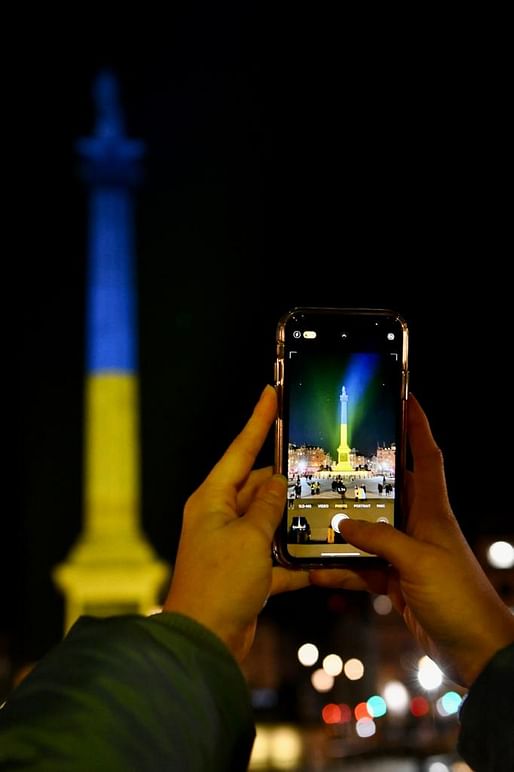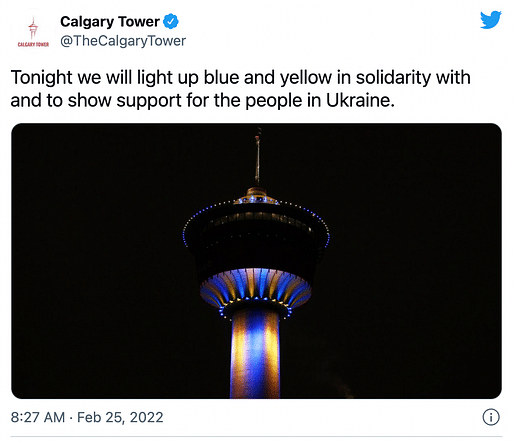

Coverage of Vladimir Putin's violent Ukraine invasion has flooded news and social media outlets since Thursday, February 24. Over the last few days, anti-war protestors around the globe have crowded city streets as they show support for Ukraine and its people.
Cities worldwide have echoed sentiments of solidarity and peace by illuminating public buildings and landmarks in Ukraine's national colors of blue and yellow. Yet, while many groups and organizations continue to send relief and aid, have we overlooked how architecture can be used to send messages of social and political expression? After all, architecture is political.
Take the recent writing of Los Angeles Times columnist Carolina Miranda. Posted on Monday evening, Miranda's perceptive take on President Zelensky's use of "architectural backdrops" shows the importance of how historic buildings, like Kyiv's Gorodetsky House (aka House with Chimeras), is being used and why it matters. Moreover, she illustrates how Zelensky's social media dispatches to Ukrainians and the world do more than communicate words of resilience and fight.
She dives into the Gorodetsky House, its architect Vladislav Gorodetsky, and the cultural relevance of the building's history. "In Zelensky's hands," writes Miranda, "this ebullient building has become a symbol of ebullient defiance, a fitting backdrop to an ideal of leadership embodied by Zelensky."
After reading her article yesterday evening, I was drawn to the symbolic parallels of cities using their regional landmarks to express visual gestures of solidarity. In times of crisis, the built environment can have polarizing effects on people. Streets, landmarks, and public monuments can represent battlegrounds of war and destruction as well as spaces for hope and resilience. With President Zelensky tirelessly fighting for his people and the nation of Ukraine, his course of action during his tenure as president makes it clear he understands the importance of sending messages of political fortitude and preserving cultural heritage. As Miranda writes, "In employing the building as a symbolic backdrop, Zelensky also seemed to be pointing to the cultural heritage that is at stake."
In times of crisis, the built environment can have polarizing effects on people. Streets, landmarks, and public monuments can represent battlegrounds of war and destruction as well as spaces for hope and resilience.
With the world watching, images of illuminated buildings in cities across the world can be found on Twitter, Instagram, Facebook, and TikTok. World leaders, local news stations, journalists, and everyday civilians continue to share their support and solidarity by documenting the spaces around them as glowing lights of blue and yellow illuminate the night. Yet, as we see countries expressing solidarity and hopes for peace towards Ukraine, some question these visual gestures of solidarity. The past two years alone have spurred powerful movements and acts of allyship. However, it's hard not to notice recurring "social media cynics" highlighting these forms of support as performative and hollow.

While it reigns true that world leaders and government allies can always do more, these visual representations of support are merely one of the many ways the rest of the world can symbolically support Ukraine. Revolving political unrest and ongoing social injustice are byproducts of the societal climate we live in today. In turn, many individuals have grown increasingly cynical and jaded. However, one must not forget how these visual representations of support can be used as a catalyst to communicate social and political expression.
Many Ukrainians who live outside of their home country can find comfort in knowing their current place of residence stands with them. That nations outside of Ukraine are aware of Putin's dictatorship and denounce his actions and senseless invasion of the country.

As nations continue to send messages of hope, safety, and anti-war cries, Ukraine's built environment and landscapes suffer from Putin's attacks. As a result, historic buildings that make up Ukraine's past and present are at risk. On February 25, 2022, The World Monument Fund shared a statement about the ongoing war in Ukraine and how Putin's attacks have left the nation and its architectural heritage in disrepair.
In a public statement to the community, the WMF shared: "World Monuments Fund (WMF) expresses deep concern as the conflict in Ukraine escalates. We urge that all precautions be taken to protect lives and avoid irreparable harm to cultural heritage in the region. Our experience with post-crisis recovery around the world continues to reveal the lasting consequences of destruction on communities."
Worried about Kyiv's historic buildings and cultural landmarks, the WMF expressed its concerns for important cultural structures like the Zhovkva Synagogue. The organization explains the synagogue is "one of eight sites where WMF has worked in the past in Ukraine. Constructed in the 1690s for a rapidly growing Jewish community, this site was included on the 2000 World Monuments Watch to ensure that the synagogue, its history, and its community will be remembered as an important part of the community's legacy. This is just one of many cultural heritage places across Ukraine now threatened by the rapidly expanding crisis. WMF calls for the respect of the 1954 Hague Convention for the Protection of Cultural Property in the Event of Armed Conflict."
It's true, these illuminated buildings and landmarks won't solve Ukraine's fight for peace and independence against Russia. However, gestures of unity provide reminders that the rest of the world hasn't completely turned a blind eye. That communities and city leaders recognize Ukraine's oppression and Putin's tyranny. While President Zelensky's use of historic buildings has a different weight and value, cities and their use of landmarks do have merit. That architecture continues to be used as backdrops for political upheaval. Landmarks and historic buildings can serve as cultural platforms and spaces for civic engagement.
As Ukraine continues to face attacks from Putin's forces, cities worldwide have used the act of lighting their landmarks to extend support. Social media has made it easy for messages of hope and outreach to travel beyond city borders. At the same time, it is important to stay vigilant and aware of misleading social shares and fake posts claiming relevance to Ukraine's invasion. Nevertheless, images of solidarity prove to be symbolic reminders that we must not lose our perspectives on humanity. That individuals who don't hold positions of power can still participate in denouncing oppression and injustice. These illuminated structures are for the people of Ukraine. They are for the Ukrainian community that lives in your towns and neighborhoods, far from their home country and families. These visual acts of solidarity and protest are for them.
So for those who are looking for ways to help at an individual level, here is a list of resources where you can donate and provide support from afar. Do you have a photo of your city showing solidarity for Ukraine? Share them in the comments section below.
Stay tuned for Archinect's continued coverage of the ongoing invasion of Ukraine and its effects on the built and cultural environment.
No Comments
Block this user
Are you sure you want to block this user and hide all related comments throughout the site?
Archinect
This is your first comment on Archinect. Your comment will be visible once approved.